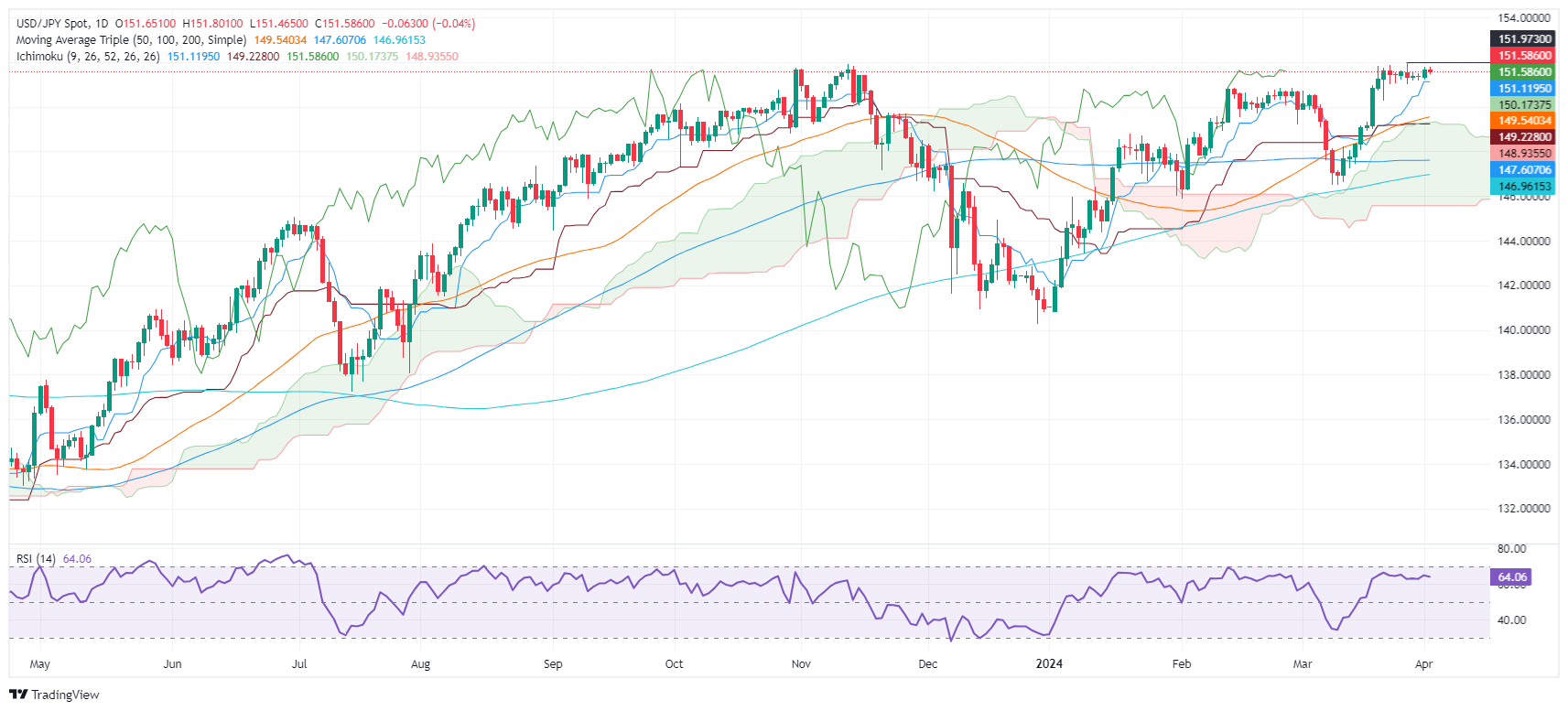USD/JPY Price Analysis: Hovers around 151.50, almost flat amid intervention threats

- USD/JPY trades subdued with potential intervention by Japanese authorities.
- Technical analysis shows 152.00 as a crucial hurdle; overcoming this could target the 153.00 level for buyers.
- A break below the Tenkan-Sen could lead to losses below 150.00, with the Ichimoku Cloud providing additional key points for traders.
The USD/JPY remained capped at around 151.50 on Tuesday amid intervention threats from Japanese authorities. The close correlation between the US 10-year Treasury notes yield, and the major hasn’t influenced the pair’s price action, which has remained below the 152.00 mark.
USD/JPY Price Analysis: Technical outlook
The USD/JPY remains capped by the 152.00 figure, though technical support lies at the Tenkan-Sen at 151.12. If buyers reclaim 152.00, that will pave the way for resting the 153.00 figure. On the other hand, if sellers push the exchange rate below the Tenkan Sen, that will pave the way to 151.00.
Once surpassed, the next support emerges at the Senkou Span A at 10.17, followed by the Kijun-Sen at 149.23. Further weakness in the pair could send it toward the Senkou Span B at 148.93, well inside the Ichimoku Cloud (Kumo).
USD/JPY Price Action – Daily Chart
Japanese Yen FAQs
The Japanese Yen (JPY) is one of the world’s most traded currencies. Its value is broadly determined by the performance of the Japanese economy, but more specifically by the Bank of Japan’s policy, the differential between Japanese and US bond yields, or risk sentiment among traders, among other factors.
One of the Bank of Japan’s mandates is currency control, so its moves are key for the Yen. The BoJ has directly intervened in currency markets sometimes, generally to lower the value of the Yen, although it refrains from doing it often due to political concerns of its main trading partners. The current BoJ ultra-loose monetary policy, based on massive stimulus to the economy, has caused the Yen to depreciate against its main currency peers. This process has exacerbated more recently due to an increasing policy divergence between the Bank of Japan and other main central banks, which have opted to increase interest rates sharply to fight decades-high levels of inflation.
The BoJ’s stance of sticking to ultra-loose monetary policy has led to a widening policy divergence with other central banks, particularly with the US Federal Reserve. This supports a widening of the differential between the 10-year US and Japanese bonds, which favors the US Dollar against the Japanese Yen.
The Japanese Yen is often seen as a safe-haven investment. This means that in times of market stress, investors are more likely to put their money in the Japanese currency due to its supposed reliability and stability. Turbulent times are likely to strengthen the Yen’s value against other currencies seen as more risky to invest in.
Information on these pages contains forward-looking statements that involve risks and uncertainties. Markets and instruments profiled on this page are for informational purposes only and should not in any way come across as a recommendation to buy or sell in these assets. You should do your own thorough research before making any investment decisions. FXStreet does not in any way guarantee that this information is free from mistakes, errors, or material misstatements. It also does not guarantee that this information is of a timely nature. Investing in Open Markets involves a great deal of risk, including the loss of all or a portion of your investment, as well as emotional distress. All risks, losses and costs associated with investing, including total loss of principal, are your responsibility. The views and opinions expressed in this article are those of the authors and do not necessarily reflect the official policy or position of FXStreet nor its advertisers. The author will not be held responsible for information that is found at the end of links posted on this page.
If not otherwise explicitly mentioned in the body of the article, at the time of writing, the author has no position in any stock mentioned in this article and no business relationship with any company mentioned. The author has not received compensation for writing this article, other than from FXStreet.
FXStreet and the author do not provide personalized recommendations. The author makes no representations as to the accuracy, completeness, or suitability of this information. FXStreet and the author will not be liable for any errors, omissions or any losses, injuries or damages arising from this information and its display or use. Errors and omissions excepted.
The author and FXStreet are not registered investment advisors and nothing in this article is intended to be investment advice.




